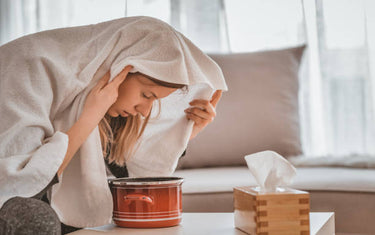5 min read / 27 August 2024 / yasmin sharp
Essential Oils for Common Ailments and First Aid
Discover the healing power of essential oils for treating common ailments and creating a natural first aid kit.
Share this post

What is the best essential oil for minor cuts and wounds?
How do you treat burns with an essential oil?
Do essential oils help headaches and migraines?
Are essential oils good for colds?
Essential oils have been used for centuries as natural remedies for a variety of ailments.
These concentrated plant extracts can provide relief for minor cuts, burns, headaches and colds.
You can make your own natural first aid kit by taking advantage of their organic properties to safeguard your health, using these oils as an alternative to shop-bought products.
However, it's crucial to use them safely and correctly. In this guide we cover the benefits, usage and safety tips for essential oils in treating common ailments and providing first aid.
What is the best essential oil for minor cuts and wounds?Every first aid kit needs a treatment for minor cuts and wounds, as you never know when you might pick up a small knock or scrape. According to research, topical use of tea tree essential oil can be helpful for healing wounds and inflammatory disorders. [1] Its natural antiseptic properties are ideal for disinfecting abrasions and cuts, killing off bacteria that could lead to an infection. Tea tree essential oil has the potential to cause an allergic reaction, so before applying it to your skin – even for a patch test – it should always be diluted with a carrier oil. Mix 2-3 drops of the oil with one tablespoon of a carrier oil of choice and apply to the affected area of the skin. It may take a few weeks of consistent use before you see results, so it is important to maintain a regular schedule during the treatment period. |

How do you treat burns with an essential oil?
Lavender essential oil is often considered to be the best option when it comes to healing minor burns.
This is likely due to the presence of an active component called beta-caryophyllene, which has been found to be successful at treating inflammation. [2]
Another study concluded that lavender essential oil had the capacity to aid wound recovery, while also reducing inflammation in women undergoing surgery during childbirth. [3]
It is a good idea to complete a patch test if you are using lavender oil on your skin for the first time, as this will tell you if it is suitable for your skin.
The correct dilution ratio for using any essential oil is to blend 2-3 drops with a tablespoon of your preferred carrier oil.

Do essential oils help headaches and migraines?
Research on using essential oils for headache and migraine pain relief is limited, so while some research provides evidence of certain benefits, they should always be used with caution.
- Stress headaches: Lavender essential oil is a recommended option for stress headaches. Many people use the oil to improve sleep and to reduce anxiety, stress or depression, with one 2022 review finding it particularly effective at combating headaches by providing some pain relief. [4]
- Tension headaches: Tension headaches typically place pressure on your temples and forehead. A 2015 review of published studies on essential oils states this pressure can be eased by topically applying diluted peppermint essential oil. This is likely due to the presence of menthol – which is the main active ingredient. [5]
- Migraines: Scientific evidence suggests that lavender essential oil can be effective at treating migraines. However, instead of topical application, it is believed that inhaling the oil can provide pain relief and significantly lower the impact of a migraine. [6]
- Sinus headaches: These types of headaches tend to cause a build up pressure around the eyes, cheeks and forehead, sometimes causing your head to throb. One of the best natural remedies is chamomile oil, which offers pain relief due to its anti-inflammatory properties. Inhaling the oil via a diffuser, tissue or direct from the bottle is the best way to use it.
Remember that you should never ingest essential oils to treat headaches (or for any other treatment) and they should always be diluted with a carrier oil before topical application.

Are essential oils good for colds?
Cold remedies made from plant extracts have been used by people for centuries, and while more research is needed, there are some studies that suggest essential oils can help.
For example, eucalyptus essential oil can provide both anti-inflammatory and antiseptic properties that are provided by the 1,9-cineole compound.
Many people use the oil as part of a cold compress to reduce fever and to combat viruses and some respiratory problems.
How to use essential oils for colds
Steam inhalation is generally seen as the best way to receive the natural healing properties provided by essential oils.
Follow the steps below to see if it works for you:
- Add no more than 7 drops of essential oil to a large bowl of boiling water.
- Cover your head with a towel and lean about 10 inches over the bowl (to avoid being burnt).
- Slowly breathe through your nose for a maximum of two minutes.
Other natural home remedies for colds you can try include inhaling directly from the bottle, or you can add a few drops to a handkerchief or cotton ball before breathing in.
Another option could be to dilute 2-12 drops of your essential oil with a carrier oil and add to warm bath water.
Alternatively, if you own a diffuser, add a few drops as usual, and allow the oil to be released into the air so you can inhale as you relax at home.

Final thoughts
Lavender, peppermint and eucalyptus essential oil are must-haves for any essential oil first aid kit.
They can be used as simple but effective home remedies that provide natural healing properties to treat colds, small cuts, headaches and burns.
Before applying any essential oil topically for the first-time, you should complete a patch test to safeguard against a potential allergic reaction and always dilute with a carrier oil.
[1] Fernanda C Flores et al. (2015) Hydrogels Containing Nanocapsules and Nanoemulsions of Tea Tree Oil Provide Antiedematogenic Effect and Improved Skin Wound Healing https://pubmed.ncbi.nlm.nih.gov/26328444/
[2] Rosaria Scandiffio et al. (2020) Protective Effects of (E)-β-Caryophyllene (BCP) in Chronic Inflammation https://www.ncbi.nlm.nih.gov/pmc/articles/PMC7692661/
[3] Katayon Vakilian et al. (2011) Healing advantages of lavender essential oil during episiotomy recovery: A clinical trial https://www.sciencedirect.com/science/article/abs/pii/S1744388110000381
[4] Arezoo Faridzadeh et al. (2022) Neuroprotective Potential of Aromatic Herbs: Rosemary, Sage, and Lavender https://www.ncbi.nlm.nih.gov/pmc/articles/PMC9297920/
[5] Babar Ali et al. (2015) Essential oils used in aromatherapy: A systemic review https://www.sciencedirect.com/science/article/pii/S2221169115001033#bib61
[6] Peir Hossein Koulivand et al. (2013) Lavender and the Nervous System https://www.ncbi.nlm.nih.gov/pmc/articles/PMC3612440/









